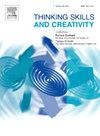Group creativity: Divergent and convergent thinking during an inquiry- and design-based project in secondary education
IF 4.5
2区 教育学
Q1 Social Sciences
引用次数: 0
Abstract
This study addresses group creativity of adolescents (aged 12 to 14 years). The aim is to shed light on their divergent and convergent thinking processes during an inquiry- and design-based project in secondary education. To meet this aim, we examined how divergent and convergent thinking emerged in students’ group conversations. Audio-recordings of 11 student groups over a one-hour session were transcribed and analyzed using thematic analysis. Our findings reveal that within a single lesson in which ideas were generated and visualized, instances of both divergent and convergent thinking patterns were found across student group conversations throughout the lesson. Regarding divergent thinking, students collaboratively expanded upon one another’s ideas, often engaging in a process that involved supporting, criticizing, rejecting or providing arguments for ideas. In addition, by clarifying the context, adolescents stimulated each other to generate or elaborate ideas. Convergent thinking patterns mostly included agreeing with each other’s ideas, and metacognitive utterances that involved stimulating one another to write down or draw ideas. Rejecting each other’s ideas appeared more difficult. As divergent and convergent thinking patterns often overlapped, the findings in the current study imply that divergent and convergent thinking cannot be considered separate stages, but ongoing and intertwined processes of generation and evaluation of ideas. Teachers are advised to address adolescent creative group processes by stimulating students to take into account end-users during divergent thinking, and to openly communicate their opinions during convergent thinking in secondary education.
小组创造力:中学教育探究与设计项目中的发散与趋同思维
本研究探讨了12至14岁青少年的群体创造力。目的是在中学教育的探究和设计为基础的项目中阐明他们的发散和收敛思维过程。为了实现这一目标,我们研究了学生群体对话中发散思维和趋同思维的表现。11个学生小组在一小时的会议上的录音被转录并使用主题分析进行分析。我们的研究结果表明,在一节课中,在产生想法和可视化的过程中,在整个课程的学生小组对话中发现了发散和收敛思维模式的实例。关于发散性思维,学生们合作地扩展彼此的想法,经常参与一个包括支持、批评、拒绝或为想法提供论据的过程。此外,通过澄清上下文,青少年相互刺激产生或阐述想法。趋同思维模式主要包括同意彼此的想法,以及元认知话语,包括刺激彼此写下或画出想法。拒绝对方的想法似乎更加困难。由于发散性思维模式和收敛性思维模式经常重叠,本研究的结果表明,发散性思维和收敛性思维不能被视为单独的阶段,而是一个不断产生和评估思想的相互交织的过程。建议教师在中学教育中,鼓励学生在发散思维时考虑最终用户,并在融合思维时公开交流他们的意见,从而解决青少年的创造性群体过程。
本文章由计算机程序翻译,如有差异,请以英文原文为准。
求助全文
约1分钟内获得全文
求助全文
来源期刊

Thinking Skills and Creativity
EDUCATION & EDUCATIONAL RESEARCH-
CiteScore
6.40
自引率
16.20%
发文量
172
审稿时长
76 days
期刊介绍:
Thinking Skills and Creativity is a new journal providing a peer-reviewed forum for communication and debate for the community of researchers interested in teaching for thinking and creativity. Papers may represent a variety of theoretical perspectives and methodological approaches and may relate to any age level in a diversity of settings: formal and informal, education and work-based.
 求助内容:
求助内容: 应助结果提醒方式:
应助结果提醒方式:


